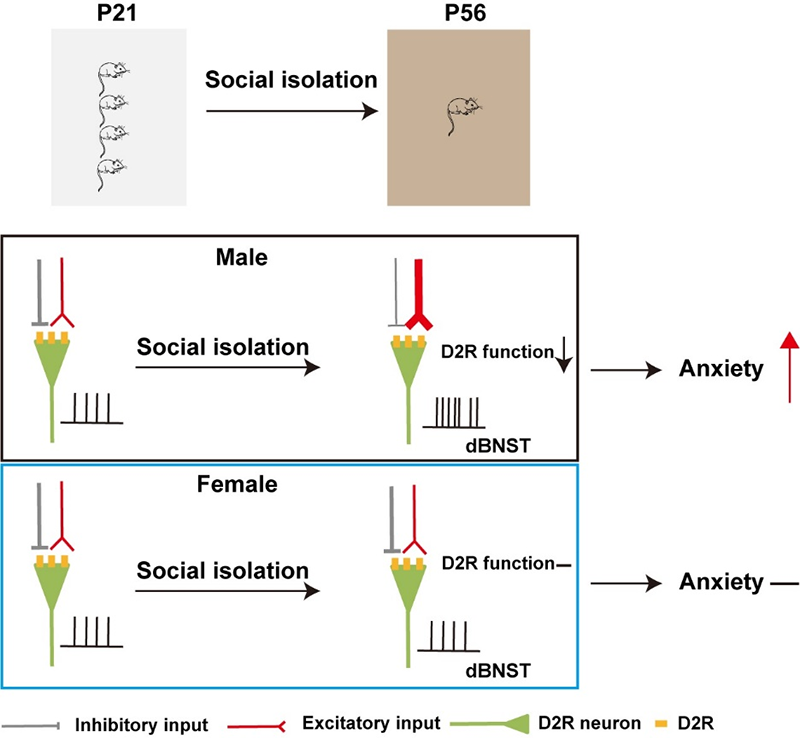Time:2023-07-25
A research team led by Dr.WANG Zuoren from the Center for Excellence in Brain Science and Intelligence Technology of the Chinese Academy of Sciences, discovered that the activity of dopamine type 2 receptor-expressing neurons (Drd2+ neurons) in the dorsal bed nucleus of stria terminalis (dBNST) increased after long-term social isolation following weaning, leading to sex-specific abnormal behavior in male and female rats, by using techniques such as patch-clamp electrophysiology, chemogenetics manipulation, in vivo pharmacology experiments, and behavioral analysis. This study elucidated the involvement of dopamine type 1 and type 2 receptor-positive neurons in the dBNST region in regulating anxiety-like behavior induced by long-term social isolation, providing potential therapeutic targets for emotional disorders caused by social isolation.
This study titled "Dorsal BNST DRD2+ neurons mediate sex-specific anxiety-like behavior induced by chronic social isolation" was published in the journal Cell Reports on July 25, 2023.
For socially inclined organisms, social isolation often leads to unhealthy psychological states and is a common source of stress. Prolonged lack of social interaction during development can result in irreversible adverse effects, including anxiety, depression, and other mental disorders.
Since the outbreak of the COVID-19 pandemic, research on social isolation has significantly increased. Previous studies have shown varying outcomes in different animals subjected to social isolation. Rats, as highly social animals, exhibit anxiety-like and depression-like behaviors along with reduced social preference after social isolation. However, the adaptive changes in the neural system during social isolation and the neural mechanisms underlying sex differences in behavior still require further investigation.
Through a series of behavioral tests, the research group found that male rats exhibited anxiety-like and depression-like behaviors, as well as reduced social preference, after social isolation, whereas female rats did not show significant changes in these behaviors. Subsequently, the researchers used in vitro brain slice electrophysiology to discover increased excitability of Drd2+ neurons in the dBNST region of male rats but no significant changes in this neural plasticity were observed in female rats. Further correlation analysis revealed a positive correlation between the excitability of dBNST Drd2+ neurons and anxiety-like behavior in male rats, but no significant correlation with depression-like behavior or social preference level.
To verify whether dBNST Drd2+ neurons are responsible for anxiety-like behavior induced by social isolation, the researchers used chemogenetic methods to activate these neurons in rats reared under normal conditions, successfully inducing anxiety-like behavior. In male rats that experienced social isolation after weaning, inhibiting the activity of this group of neurons alleviated anxiety-like behavior.
Finally, the researchers found that male rats subjected to social isolation exhibited sex-specific functional impairments of dopamine type 2 receptors in the dBNST region after weaning. This finding might contribute to the neural mechanism underlying sex-dependent anxiety abnormalities caused by social isolation.
This research work was primarily conducted by ZHENG Chaowen,WEI Lei and LIU Boyi under the guidance of WANG Zuoren. HUANG Yanwang, WANG Shangyi, and WANG Qingxiu made important contributions to this study. Professors GONG Hui and LI Xiangning from Huazhong University of Science and Technology provided important technical support. The research work was supported by the grants from Chinese Academy of Sciences, the Ministry of Science and Technology, Shanghai Municipal Science and Technology and the National Natural Science Foundation of China.

Figure top Schematic diagram of the method for modeling social isolation after weaning. middle In male rats experiencing long-term social isolation, there is an increase in excitatory inputs and a decrease in inhibitory inputs to the Drd2+ neurons in the dBNST brain region. Additionally, the functionality of dopamine type II receptors is weakened, leading to an increase in neuronal firing. The animals exhibit increased anxiety-like behavior. bottom In female rats experiencing long-term social isolation, there are no changes in the excitatory inputs, inhibitory inputs, dopamine type II receptor functionality, or neuronal firing of the Drd2+ neurons in the dBNST brain region. As a result, the animals show no changes in anxiety-like behavior.
Keywords: Neural Mechanism ; Sex-Dependent Anxiety-like Behavior ; Social Isolation
Author contact:
WANG Zuoren
Center for Excellence in Brain Science and Intelligence Technology, Chinese Academy of Sciences, Shanghai, China.
E-mail: zuorenwang@ion.ac.cn
 附件下载:
附件下载: